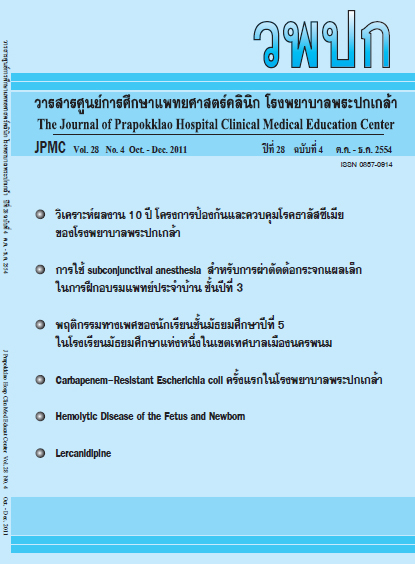Superior/inferior subconjunctival anesthesia for manual small-incision cataract surgery in a residency training program: a preliminary report
Main Article Content
Abstract
Purpose : To evaluate the effectiveness of subconjunctival anesthesia for manual small-incision cataract surgery in a residency training program.
Setting : Department of Ophthalmology, Prapokklao Hospital, Chanthaburi, Thailand
Methods : This prospective study was performed in 61 patients at Prapokklao Hospital, Chanthaburi, Thailand. Patients undergoing manual small-incision cataract surgery by the third-year ophthalmology residents received subconjunctival anesthesia for pain control. The surgery was performed through a superior scleral tunnel incision with the Modified Blumenthal technique. Pain visual analog score, operative time, operative and anesthetic complications were evaluated.
Results : Sixty-one patients had successfully undergone cataract surgery under subconjunctival anesthesia but three patients required supplemental
subconjunctival anesthesia. The median pain score (interquatile range) was 10 mm (0-30 mm) for delivery of anesthesia, 50 mm (20-70 mm)
during the surgery, and 20 mm (0-30 mm) postoperatively. Mean operating
time was 47.65 ± 10.53 minutes (SD). Subconjunctival hemorrhage (14 cases) and capsular tear (2 case) were observed.
Conclusion : Subconjunctival anesthesia is an effective and easy-to-administer anesthetic procedure for manual small-incision cataract surgery in a
residency training program. It is important that the residents should be experienced in the surgical technique and that patients are carefully
selected
